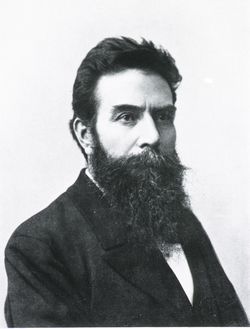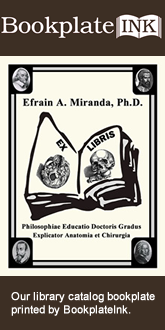
Medical Terminology Daily (MTD) is a blog sponsored by Clinical Anatomy Associates, Inc. as a service to the medical community. We post anatomical, medical or surgical terms, their meaning and usage, as well as biographical notes on anatomists, surgeons, and researchers through the ages. Be warned that some of the images used depict human anatomical specimens.
You are welcome to submit questions and suggestions using our "Contact Us" form. The information on this blog follows the terms on our "Privacy and Security Statement" and cannot be construed as medical guidance or instructions for treatment.
We have 864 guests online

Georg Eduard Von Rindfleisch
(1836 – 1908)
German pathologist and histologist of Bavarian nobility ancestry. Rindfleisch studied medicine in Würzburg, Berlin, and Heidelberg, earning his MD in 1859 with the thesis “De Vasorum Genesi” (on the generation of vessels) under the tutelage of Rudolf Virchow (1821 - 1902). He then continued as a assistant to Virchow in a newly founded institute in Berlin. He then moved to Breslau in 1861 as an assistant to Rudolf Heidenhain (1834–1897), becoming a professor of pathological anatomy. In 1865 he became full professor in Bonn and in 1874 in Würzburg, where a new pathological institute was built according to his design (completed in 1878), where he worked until his retirement in 1906.
He was the first to describe the inflammatory background of multiple sclerosis in 1863, when he noted that demyelinated lesions have in their center small vessels that are surrounded by a leukocyte inflammatory infiltrate.
After extensive investigations, he suspected an infectious origin of tuberculosis - even before Robert Koch's detection of the tuberculosis bacillus in 1892. Rindfleisch 's special achievement is the description of the morphologically conspicuous macrophages in typhoid inflammation. His distinction between myocardial infarction and myocarditis in 1890 is also of lasting importance.
Associated eponyms
"Rindfleisch's folds": Usually a single semilunar fold of the serous surface of the pericardium around the origin of the aorta. Also known as the plica semilunaris aortæ.
"Rindfleisch's cells": Historical (and obsolete) name for eosinophilic leukocytes.
Personal note: G. Rindfleisch’s book “Traité D' Histologie Pathologique” 2nd edition (1873) is now part of my library. This book was translated from German to French by Dr. Frédéric Gross (1844-1927) , Associate Professor of the Medicine Faculty in Nancy, France. The book is dedicated to Dr. Theodore Billroth (1829-1894), an important surgeon whose pioneering work on subtotal gastrectomies paved the way for today’s robotic bariatric surgery. Dr. Miranda.
Sources:
1. "Stedmans Medical Eponyms" Forbis, P.; Bartolucci, SL; 1998 Williams and Wilkins
2. "Rindfleisch, Georg Eduard von (bayerischer Adel?)" Deutsche Biographie
3. "The pathology of multiple sclerosis and its evolution" Lassmann H. (1999) Philos Trans R Soc Lond B Biol Sci. 354 (1390): 1635–40.
4. “Traité D' Histologie Pathologique” G.E.
Rindfleisch 2nd Ed (1873) Ballieres et Fils. Paris, Translated by F Gross
"Clinical Anatomy Associates, Inc., and the contributors of "Medical Terminology Daily" wish to thank all individuals who donate their bodies and tissues for the advancement of education and research”.
Click here for more information
- Details
This article is part of the series "A Moment in History" where we honor those who have contributed to the growth of medical knowledge in the areas of anatomy, medicine, surgery, and medical research.

Prof. Wilhem-Conrad Roentgen
Wilhelm Konrad Roentgen (1845 - 1923). A German physicist, Professor Roentgen started studying Physics at the University of Ultrech, and receiving his degree from the University of Zurich. Having observed fluorescence on a paper covered with barium platinocyanide close to an active cathode ray. Suspecting the presence of "invisible rays", he devised an experiment to prove this.
On November 8, 1895 he confirmed his theory and called these invisible-to-the-eye emissions "X"-rays. He also observed the action of these "X"-rays on photographic plates, and that these rays could traverse through the human body, showing the bones. In fact, the first "roentgenogram" was an image of his wife's hand. If you hover over Professor Roentgen's image, you will see an depiction of this historic image. This image marks the beginning of the science of Radiology.
Professor Wilhelm Konrad Roentgen received many awards, medals, and recognitions. In 1901 he was awarded the Physics Nobel Prize.
Sources:
1. http://www.nobelprize.org
2. "The origin of Medical Terms" Skinner, HA; 1970
Both original images (1) and (2) are in the public domain and courtesy of the National Library of Medicine.
Thanks to Megan Ohse for suggesting this article
- Details

Sulcus/gyrus and brain, lateral view
These two different terms must be analyzed together. The Latin term [sulcus] means "groove or fissure". Its plural form is [sulci]. There are many anatomical sulci in the body, one of them being the costal sulcus in the ribs.
The second term [gyrus] is also Latin and means "circle or ring", as used in the words gyroscope or gyrations. In its adjective or descriptive form, [gyrus] is used to denote something "bent, curved, or broad-shouldered"1. The plural form is [gyri]. In the case of the brain a gyrus is formed as a mound or an elevation between the "valleys" of the sulci (see image). If you click on the image a secondary image depicting the lateral aspect of the brain will appear.
In the brain there are many sulci, the secondary image shows the lateral or Sylvian sulcus, and the central sulcus or sulcus of Rolando.
In relation to the central sulcus there are two gyri. The anteriorly situated precentral gyrus is considered the primary motor cortex and associated with voluntary motor activity (colored in green in the secondary image). The postcentral gyrus (colored in blue) is situated posterior to the central sulcus and is the primary sensory cortex, associated with somatic (bodily) conscious sensation.
Sources:
1. "The Origin of Medical Terms" Skinner, HA 1970 Hafner Publishing Co.
2. "Medical Meanings - A Glossary of Word Origins" Haubrich, WD. ACP Philadelphia
3 "Tratado de Anatomia Humana" Testut et Latarjet 8 Ed. 1931 Salvat Editores, Spain
4. "Anatomy of the Human Body" Henry Gray 1918. Philadelphia: Lea & Febiger
Initial image by:Albert Kok,courtesy of:Wikipedia.org. Second image modified from the original image by Henry Vandyke Carter, MD., courtesy of bartleby.com
Terms suggested by Sara Mueller.
- Details
This article is part of the series "A Moment in History" where we honor those who have contributed to the growth of medical knowledge in the areas of anatomy, medicine, surgery, and medical research.
Adam Christian Thebesius (1686- 1732). German physician and anatomist, Thebesius studied in the University of Leiden, Netherlands, where he received his doctorate in 1708 with the thesis "De circulo sanguinis in corde" (on the circulation of the blood in the heart). In 1713 he became a member of the Royal Academy of Natural Scientists (Kaiserliche Akademie der Naturforscher), where he adopted the Latin name "Eyryphon". Besides his natural sciences and medical research, Thebesius developed an interest in astrophysics.
Extremely interested in coronary circulation, Thebesius injected dyes and fluids in the coronary arteries, veins, and coronary sinus. Along with Raymond Vieussens (1635-1713) , Thebesius described all these structures. Today his name is attached to the eponymic Thebesian veins (venae cordi minima), and the Thebesian valve guarding the exit of the coronary sinus into the right atrium of the heart. Both these structures were mentioned in his 1708 doctoral thesis
Sources:
1. “The Role of the Thebesian Vessels in the Circulation of the Heart” Wearn, J.T. J Exp Med. 1928 January 31; 47(2): 293–315
2. The Story Behind the Word. Some Interesting Origins of Medical Terms. Wain,H. 1958.
3. The Origin of Medical Terms. Skinner, H.A. 1970
Original image in the public domain, courtesy of the National Library of Medicine
- Details
The ventricular system of the brain is an interconnected system of cavities and ducts within the brain through which cerebrospinal fluid (CSF) circulates. The CSF is produced in the choroid plexuses located within the ventricles.
There are two large curved lateral ventricles, each found within a cerebral hemisphere. They connect with the third ventricle via an opening called the "foramen of Monro". The third ventricle connects with the fourth ventricle by way of a slender canal called the "cerebral aqueduct" or the "aqueduct of Sylvius".
The third ventricle is found deep within the brain between the right and left diencephalic portion of the cerebrum.
The fourth ventricle is located between the pons of the brain stem anteriorly and the cerebellum posteriorly. This ventricle has a rhomboidal shape and it connects with the external aspect of the brain and the subarachnoid space. Failure of this CSF drainage from the ventricles to the subarachnoid space can lead to pathological accumulation of CSF within the ventricles and hydrocephalus.
The line drawn image shows a lateral view of the brain with a superimposed image of the ventricular system. If you click on this image, you will see a superior view of a cast of the ventricular system (by Retzius).
The dissection image shows a posterior view of the brain stem and the cerebellum which has been opened in the median plane to expose the 4th ventricle. Click on the image to see a larger version.
Line images in the public domain by Henry VanDyke Carter, MD. (Gray's Anatomy) Dissection images property of CAA, Inc. Photographer E. Klein
- Details
The cerebrospinal fluid (CSF) is a colorless, transparent fluid produced from the arterial flow of blood by the choroid plexuses found within the ventricular system of the brain. The CSF exits the ventricular system and enters the subarachnoid space and its cisterns. It is then absorbed at the level of the arachnoid granulations into the venous component of the cardiovascular system.
The CSF has many functions, some of them being protection, the creation of a fluid environment where the brain 'floats", cleansing, and others. For a more detailed description of the CSF, click here.
The CSF is produced at an average rate of 550-700ml/day. It is absorbed at the same rate. An imbalance between production and absorption of CSF (as well as a blockage within the ventricular system) can lead to an accumulation of CSF within the brain, causing hydrocephalus.
- Details
This article is part of the series "A Moment in History" where we honor those who have contributed to the growth of medical knowledge in the areas of anatomy, medicine, surgery, and medical research.
Hippocrates of Cos (460 BC - 370 BC). A Greek physician, Hippocrates was born on the Greek island of Cos (Kos) c. 460BC. Considered the "Father of Medicine" he removed Medicine from the realms of superstition and magic. He was the first to record medical writings and is considered the first one to use and maintain proper medical terminology. There are many writing attributed to Hippocrates, but there is no assurance that these were actually written by Hippocrates himself. Hippocrates changed the art of medical diagnosis by replacing supernatural precepts with observation-based methodology. Natural, rather than supernatural causes, would from here on explain all disease processes, what was known as Rational Medicine.
He is known for having set the oath that governs medical principles, the Hippocratic Oath, although there are many authors that contend that this oath was written long time after he died.
Sources:
1. "Hippocrates himself" JAMA. 1968;204(12):1138-1139
2. "Hippocrates: father of medicine" Tan, S Y (01/01/2002). Singapore medical journal(0037-5675), 43(1), p.5.





